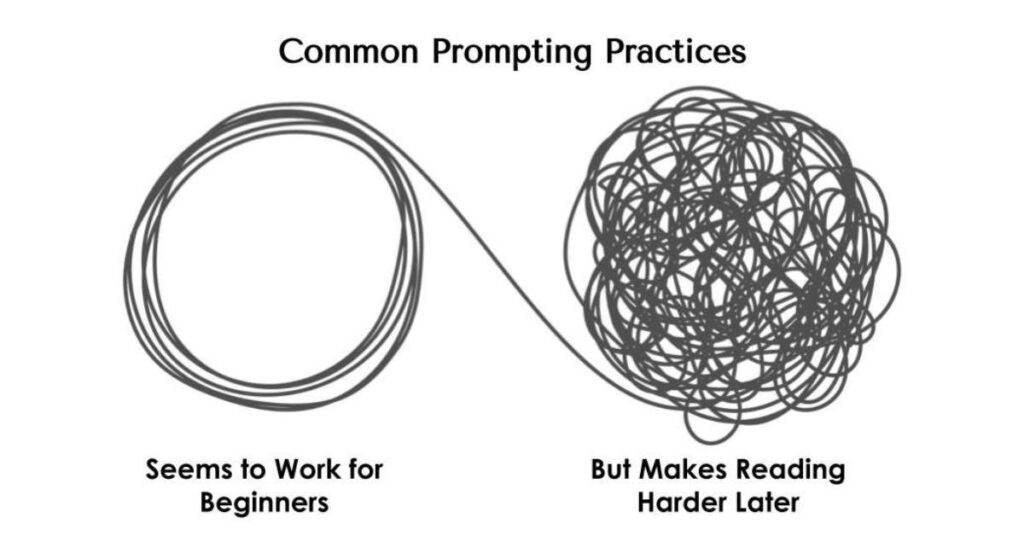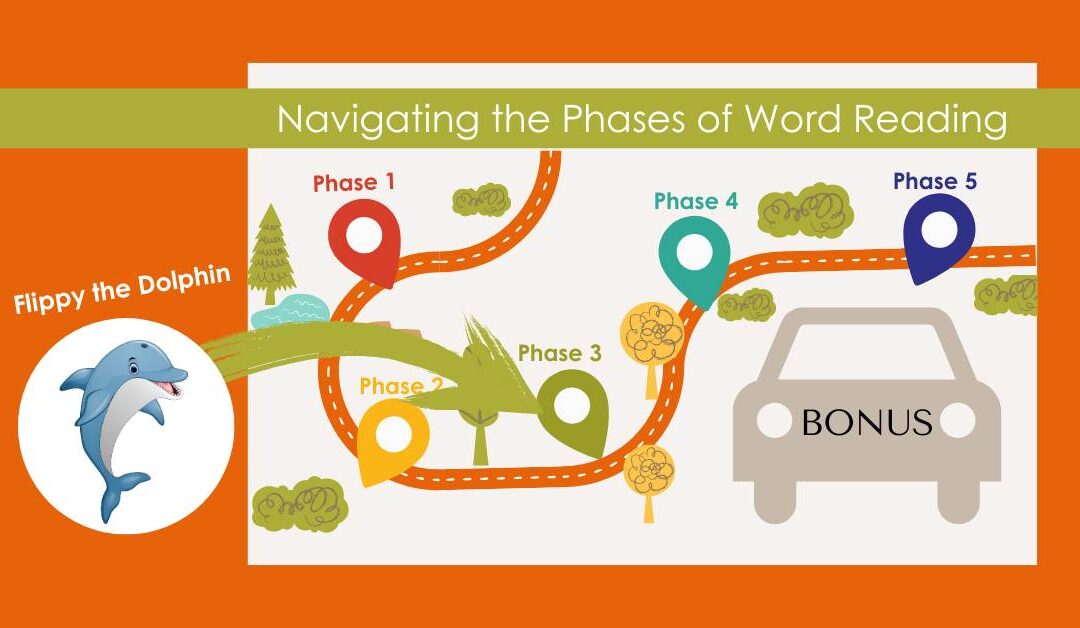We are glad you are here for this bonus blog as we reach the end (really!) of our six-part (turned seven-part) series on the ways that familiar prompts may or may not be good for students in the long run.
As it turns out, some of the familiar prompts that we have grown to rely on simply don’t hold up over time. They look like they are working because children can “say” the words on the page through prediction, picture clues, and/or memorization. But these strategies fall apart for children down the road because “saying” the words is different than actually reading the words.
If you are just now joining us, the first blog in this series introduced Ehri’s phases of word reading (1987, 1995, 2002, 2005, 2017). The second blog through the fifth blog each explored a different common prompt (often taught via a friendly Beanie Baby mascot) that turns out to be riddled with roadblocks for readers. We connected each prompt to the particular phase of word-reading that it encourages. Finally, blog six and blog seven (this one) explore two common prompts (and their mascots) that we think are worth holding on to.
Today’s guest is Flippy the Dolphin. Flippy’s job is to encourage students to “flip” the vowel, trying an alternate sound for the spelling when the first decoding attempt doesn’t sound quite like a word they know.
Teacher directions for introducing Flippy tend to be something like:
“If the short vowel doesn’t make sense, then try the long vowel.”
This prompt encourages a few important moves on the part of the reader:
- It makes space for sound-by-sound blending (phonic decoding) because it doesn’t include other detours or suggestions for going “around” the word. It prompts students to think about whether their decoding attempt makes sense in two different ways.
- Sense on the word-level: Does it sound like a word I know?
- Sense in the larger context of the sentence: Does it make sense with the rest of the sentence (paragraph, passage, text)?
- If the word does not make sense, the prompt suggests a specific way to change the word attempting to “flip” it into one that does make sense.
The science-y term for “flipping” sounds in a word to get closer to one you know is set for variability. This is the work of leveraging context to get from a first attempt at decoding a word to a more likely pronunciation of the word.
Reading is translating print back into speech. So, the work of reading is always about reconciling the alphabetic and the speech systems as we navigate the gap between them.
Sometimes readers encounter a word that – despite their best attempts – they can’t accurately decode. This difficulty might be because they haven’t yet learned all of the sound-spellings in the word, because the word contains irregular spellings, or because they don’t understand how syllables work. When these challenges arise, set for variability can be the key to bridging the gap between the “not quite right” word and the actual word. Of course, to bridge this gap, the word has to be in the reader’s speaking vocabulary in the first place.
For example, a beginning reader might encounter the word bread in the following sentence:
We had jam and bread for lunch.
The reader might read the word bread as “breed” because they know that EA can represent the long E sound, as it does in the word read. So, despite the inaccurate outcome, their approximation with the word “breed” is entirely plausible for a reader working in the full-alphabetic phase and making use of all of the print in a word (rather than guessing or letter sampling).
But, decoding attempts should always be followed with confirming that the word makes sense. This confirmation involves two (sometimes three) questions. In the bullets below, we walk you through those questions, with the word bread–decoded as “breed”–from the sentence above:
- Does “breed” sound like a word I know? (Yes, even though it is an incorrect approximation. Hmmm.)
- Does “breed” make sense in the sentence? (No, because breed is not something to eat.)
- Because the answer to one or both of the first two questions is “no,” then we need to ask one of these questions: What happens when I change the long E sound in “breed” to a short E? OR What word do I know that sounds almost like “breed” and also makes sense in the sentence? (Bread! Yes. Bread makes sense!)
Because vowels are the most likely culprits for tripping us up when it comes to mispronouncing a word, flipping the vowel sound will often help a reader arrive at the correct pronunciation–confirmed by its relevance in the sentence.
And although it may seem a little bit like telling children to look at the first letter and think about what would make sense (something we certainly DON’T want to do!), there is a critically important difference: in the full alphabetic phase readers process all of the print, make a plausible attempt, and then – if they notice something doesn’t seem right – try a different sound for at least one of the spellings – usually a vowel – as they work to move from an almost-but-not-quite-right attempt to the actual word.
As it turns out, this “difference” (looking at all of the print vs. just the first or a few letters) makes all the difference in the world to readers and how they will fare as texts get increasingly complex. So, Flippy’s prompt to try flipping a sound in a not-quite-right word turns out to be brain-friendly advice for readers, after all!
In fact, there are at least three benefits of teaching children to try flipping (or flexing) the vowel sound when something seems off with a full-alphabetic decoding attempt:
- Flipping the vowel can act as a scaffold for set for variability, helping readers build some understanding of how to listen to their approximation and adjust it slightly to a recognizable word that makes sense in the context.
- Flipping the vowel can serve as support when readers encounter vowel spelling patterns they haven’t yet learned. After engaging set for variability, if they take a moment to align the newly noticed vowel spelling pattern with the sound it represents, they also have the opportunity to teach themselves new sound-spellings!
- Flipping the vowel is a necessary strategy for working through multi-syllabic words. Because syllabication rules are not completely reliable, flexibility in vowel pronunciation becomes increasingly important as words get longer.
Flipping sounds is something we all do when we try to move from an initial decoding attempt to a word that is both recognizable and makes sense in the sentence. And with a slight change in the directions that go with Flippy, we can further strengthen the prompt. We would say something like:
“Blend all the way through the word.
If the word you get doesn’t make sense,
try a different vowel sound.”
So go ahead. Give Flippy, as a counterpart to Stretchy the Snake, continued permission to help out in your classroom. In doing so, you will offer students a strategy for navigating unknown or irregular spellings, using the sound-spellings they know to figure out (and sometimes even learn!) new ones.
References
Ehri, Linnea C. 1995. “Phases of Development in Learning to Read Words by Sight.” Journal of Research in Reading Research 18 (2): 116-125.
Explore the whole blog series:
Showing Young Readers How to Navigate the Phases of Word Reading
Part 1: A Journey Through Ehri’s Phases
Part 2: Why Looking at the Pictures Isn’t as Helpful as We Thought
Part 3: Why Looking at the First Letter of the Word Isn’t Enough
Part 4: Problems With Skipping Words
Part 5: The Downsides of Asking Children to Search for Chunks in Words
Part 6: The Power of Teaching Students to Blend Words
BONUS: The Power of Teaching Readers to Try Alternate Sounds



This series is incredibly useful! Thank you so much for helping us understand what are the most useful cues we can give to our students.